Part 7: British Railways - The Diesel Era (continued)
It is often said the Class 21s were sent to Scotland to be near the NBL works in Glasgow but this appears to be a myth. A look at records for random members of the class indicates repairs and overhauls in Scotland were done at BR workshops, not at the NBL works. There is also the question of why the Western Regions diesel-hydraulic versions were not sent north if "to be near the NBL works" was true, but then no BR regions bar the Western wanted diesel-hydraulic main line types. It would seem the Western Regions NBLs were for some reason rather more reliable although admittedly far from perfect. This was especially true of the Class 43 Warships.
Another, less heard, story says the Class 21s were sent to Scotland to get them well away from London in order to avoid their constant failures on commuter trains drawing attention and awkward questions being raised in parliament. This sort of thing did happen; one actual example occurred as late as 1971 when questions were raised in the House of Commons regarding the short lives of the BR diesel railbuses and the taxpayers money thus wasted. We will probably never know the truth regarding the Class 21s. Perhaps there is an element of truth in both alleged reasons.
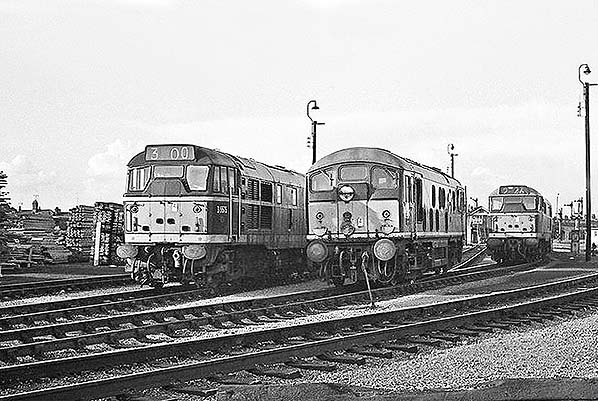
© Chris Burton
Again in September 1964 we see, D5575, D5045 and D5603 on 'the dump'. Readers may have noticed that by this time coupling codes for multiple working were beginning to appear on locomotives. Both the Brush Type 2s, above, carry the 'blue star' code just above their buffers. This code, which signified electro-pneumatic control, was to become the standard for diesel-electric main line locomotives. Diesel multiple units used a totally different set of codes, as we will see later.
D5045, then Ipswich based, was one the BR / Sulzer Type 2s which later became Class 24. Sulzer were a Swiss company and their engines, built under licence by Messrs Vickers, were widely used by BR in Type 2, 3 and 4 locomotives. What became Classes 24 - 27 used the Sulzer 6LDA28 engine in its various versions. The 6LDA28, being a mere 6-cylinder unit, gave the locomotives so-fitted a very distinctive low-pitched throbbing sound when idling. Indeed, railwaymen and enthusiasts could identify any diesel locomotive type just by the sound of its engine. One of the drawbacks with the Sulzer 6LDA28 was that it caused vibrations which could be quite irritating in the cab.
All three locomotives seen above are fitted with connecting doors in their cab fronts. This was a throwover from the days of corridor tenders on steam locomotives intended to permit crew changes when on the move. With the diesels, these doors were rarely, if ever used and later builds omitted them altogether while many locomotives fitted with them from new had them sealed or plated over. To allow access into locomotives from trains, a gangway adapter had to be used, or at least in theory for as far as is known none were ever used. Quite why BR specified these doors on locomotives which were never intended for long distance passenger services, such as those seen above, which may call for crew changes on the move is something of a mystery. In the event, all these doors did was make the locomotives appear untidy and fill their cabs with draughts.
Cambridge played host to members of Class 24 from both Ipswich and Hornsey depots. The first 20 Class 24s were 'pilot scheme' offerings. They were not unattractive locomotives, especially in 'skinhead' form, but Derby works made a total mess of the bodyside grille arrangements. The later builds, of what became Class 25, were much tidier all round including the cabs which by then lacked gangway doors. The Class 24s vacated the area c1967 and ended up joining others in Scotland, North Wales and other areas of the London Midland Region. All had been withdrawn by the 1980s and a few have survived into preservation.
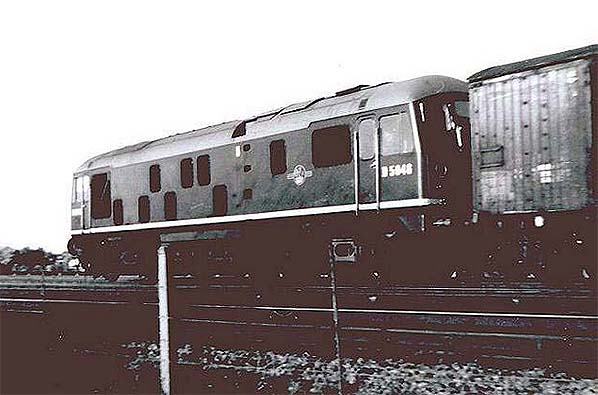
Photo by Stewart Ingram
Above is D5046 at Chesterton Junction c1963. It is not entirely clear if the train is taking the St Ives or Ely line but appears to be the latter. The St Ives line had a down loop at this time and this can confuse images such as that above. Trains could also run 'wrong line' in order to access various sidings. The image illustrates well the messy arrangement of bodyside grilles found on these locomotives. The steps on the bodyside and the roof rebate gave access to the train heating boiler tank. 2 End of the locomotive is nearest the camera.
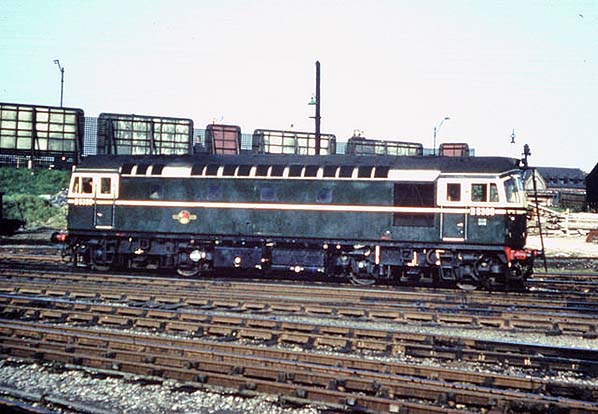
Photo from Rick2E's Flickr photostream
Yet another type at Cambridge during the early diesel period was the Birmingham Railway Carriage & Wagon Co. (BRCW) Type 2, later Class 26. Above is seen D5309 chuntering away to itself near Hills Road bridge. The date is unknown but will probably be some time during 1959. The type was in effect a private industry version of the BR Type 2 seen previously and BRCW did a much better job than did Derby works. The cabs were neater and the bodysides were much tidier. The messy grille arrangement of the BR version caused much dust and dirt ingress. BRCW were wise enough to locate most of the grilles to just above the cantrail, as can be seen above. The large bodyside grille at 1 end, on the right, was the cooling block air intake which exhausted via roof mounted fans. By necessity this had to remain on the bodyside and was a feature common to most main line diesel types. The cantrail grille arrangement was to be copied by BR and was most evident with the later Class 25 builds. The Class 26 and later Class 27 variant ultimately ended up in Scotland where they became a familiar sight for many years. Apart from Hornsey, others once operated in the East Midlands and in North East England. Several members of both classes have survived into preservation; Class 27 having bowed out of BR service in 1987 while Class 26 soldiered on until 1993, having proved more reliable than the Class 27 which had different electrical equipment and the later 6LDA28-B engine.
In the background of the above image, on Hills Road, two of the distinctive street lamps once familiar across Cambridge can be seen. At the time of writing a few still survive. The standards originally supported gas lamps which were cantilevered from the spigots just visible a few feet down from the top. At certain locations in Cambridge, the gas lamps were quite ornate.
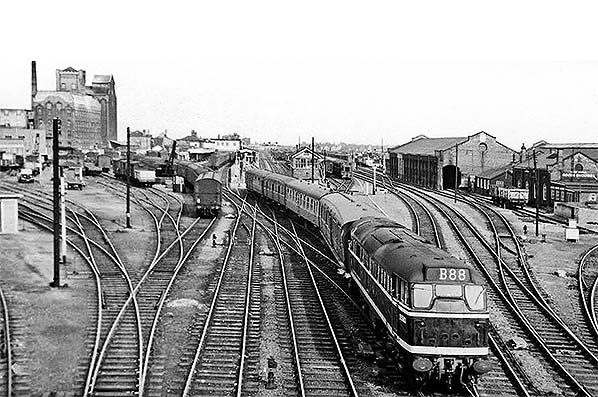
Photo by Ben Brooksbank
Above, one day in October 1960 Brush Type 2 D5563 departs Cambridge with the 11:45 stopping service to Liverpool Street. The locomotives headcode is another example of the system then peculiar to the Great Eastern section. The train is a short 5-car rake and includes a BR Mk1 in 'blood & custard' livery. D5563 was still Mirrlees-engined at this time and will be making the characteristic and mildly comical gurgling sound of these engines as it accelerates under Hills Road bridge.
On the left, Coalfields Sidings are still busy with sundry goods traffic and the unusual crane is still in position. To the right of the signal box a Class 03 shunter sits between shuffles in the carriage sidings. The vehicle behind the shunter appears to be a diesel railbus but it is too far away from the camera to confirm.
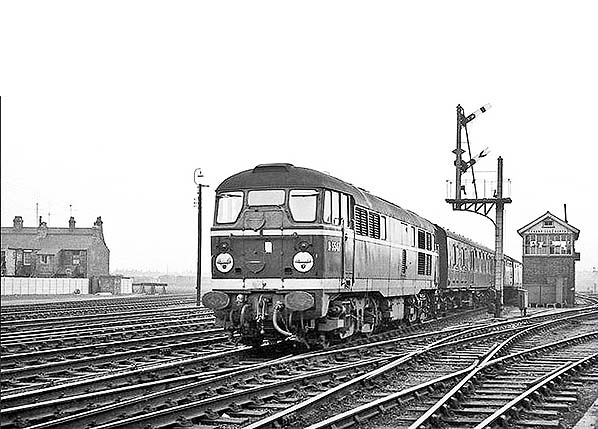
© Chris Burton
Above, in February 1962 March-based D5547 departs Cambridge with the 12:36 ex Liverpool Street service to King's Lynn. Apart from the addition of the electrification warning flash, the locomotive is in original condition. In the centre of the cab front a headboard bracket can be seen; a number of class members were fitted with this device. Despite being a 'skinhead', D5547 was one of the production batch. Some 55 of the class were built in this condition, with headcode discs, before roof-mounted headcode boxes appeared. In the left background, some idea can be gained of the extent of the goods yard at this time.
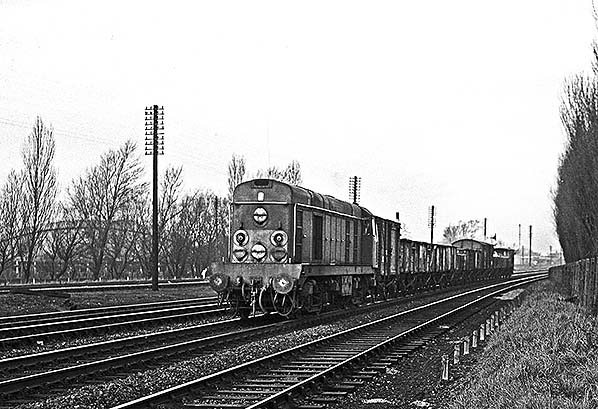
© Chris Burton
Apart from the locomotives which turned up at Cambridge on fill-in or running-in turns from King's Cross, the big Deltics, the Peaks and so on, another type not yet mentioned which was once common was the EE Type 1 or Class 20 as it became. Above, in March 1965, D8027 is seen on 8B57; the 16:24 pick-up goods for the Great Northern line. The location is just south of Cambridge station, opposite the end of Purbeck Road. This is the point at which the London and Bedford lines begin to part company; the latter can be seen on the far left. D8027 is on the up main while to its left is the down main. The other two tracks were the up and down relief roads which stretched from just south of Hills Road to Long Road.
The EE Type 1 was another 'pilot scheme' offering with the first of the Class, D8000, being the very first locomotive under that scheme to be delivered. Apart from a couple of minor engine issues which were quickly sorted out, the class was just about the only 'pilot scheme' design which worked straight from the box trouble-free. Dating from 1957, D8000 - 19 first went to Devons Road while D8020 - 7 went to Hornsey. Building continued up to 1968 with a total of 227 being built. Later examples had headcode boxes. A few could also later be seen on the Great Eastern section, based at Stratford, one usually being used as Liverpool Street pilot for a time after the Class 15s were withdrawn.
The Hornsey examples could be seen on passenger work during the summer months (they did not have train heating supplies) and at other times of the year when deputising for failed Baby Deltics, including to Cambridge. Later the class became concentrated on the London Midland Region and in Scotland but could - and did - still turn up almost anywhere. They were prolific at Whitemoor where they arrived with freight trains and even after leaving Hornsey still appeared at Cambridge -and at the time of writing still do on occasion as small number remain in service.
The class was and still is commonly seen running in pairs coupled nose to nose to eliminate the visibility problems caused by the long noses. Some saw service in France for a time. Many are now scrapped while some have moved into preservation, including D8000. The few which remain in service are likely to continue to do so for the immediate future; much of their work is nuclear flask trains but at the time of writing some are employed on delivering new S Stock trains to London Underground.
It will have been noticed that visibility issues have been mentioned herein in respect of all the single-cab Type 1 designs. It should be remembered that when these locomotives were introduced, drivers were used to steam locomotives with similar restricted forward vision so at the time it was not seen as a problem with the diesels. As steam men retired and new recruits were trained on diesels and safety concerns began to rule the world, forward visibility from the single cab diesels became more of an issue, hence the running of nose to nose pairs.
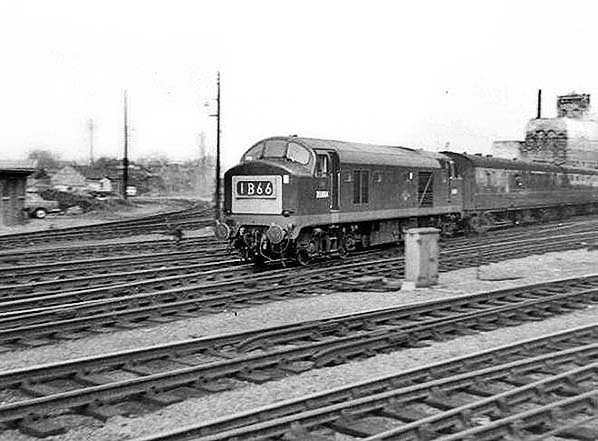
Photo by Stewart Ingram
The English Electric Baby Deltic, later Class 23, is the last of the 'pilot scheme' diesels relevant to Cambridge. Having produced their excellent Type 1 design seen in the previous image, EE turned what must surely be the worst diesel class ever to haunt British Railways. Only ten were built, D5900 - D5909, for outer suburban services between King's Cross, Moorgate, Broad Street and Cambridge. They also worked passenger trains to Huntingdon and occasionally as far north as Peterborough. Above, in May 1965, D5904 roars away from Cambridge with an up 'Buffet Express'. The smoke obscuring the background will be from the locomotive. The Cambridge 'Buffet Express' never carried a headboard - it was only a semi-fast outer suburban train, after all - but did once carry carriage roof boards. One can just be seen on the first carriage. The CBE was also, briefly, extended to Ely during early diesel days and thus the Baby Deltics could be seen leaving trails of smoke north of Cambridge as well as south.
As already mentioned, many diesel locomotive engines were developed from marine applications and the Napier Deltic engines were a WWII design for, primarily, Royal Navy motor torpedo boats. The big Class 55 Deltics used a pair of 18-cylinder units; the cylinders were arranged in six banks of three with each bank in a delta configuration, hence the Deltic name. They were two-stroke, opposed piston engines so 18 cylinders meant 36 pistons, hence a total of 72 pistons in each class 55 locomotive. The Class 23 Baby Deltics used a smaller 9-cylinder version, the T9-29, which meant a total of 18 pistons. The arrangement necessitated three crankshafts per engine linked via gearing to a common power output shaft. In a nutshell, so to speak, all the Deltics were a maintenance nightmare and an expensive one at that.
 The Napier Deltic engine was, as we have seen, 2-stroke and this obviously necessitated inlet and exhaust ports in the cylinder liners. These liners cracked around the ports, allowing coolant into the cylinders. This in turn caused piston seizure which resulted in connecting rods being ejected, often at high velocity, through the side of the crankcase. If only this was the only problem with the Baby Deltics. They suffered cooling problems and ancilliary equipment was a constant source of trouble. It would appear EE themselves may have been partly to blame; the British Transport Commission placed the order but EE were late issuing the internal order which allowed construction to begin. This in turn, it seems, was the reason why EE bought-in a number of components which, to use a modern term, were 'unfit for purpose'. There may also be a connection between this and BR initially refusing to accept the locomotives as they came out overweight (a common problem at the time), modifications having to be made to reduce weight.
The Napier Deltic engine was, as we have seen, 2-stroke and this obviously necessitated inlet and exhaust ports in the cylinder liners. These liners cracked around the ports, allowing coolant into the cylinders. This in turn caused piston seizure which resulted in connecting rods being ejected, often at high velocity, through the side of the crankcase. If only this was the only problem with the Baby Deltics. They suffered cooling problems and ancilliary equipment was a constant source of trouble. It would appear EE themselves may have been partly to blame; the British Transport Commission placed the order but EE were late issuing the internal order which allowed construction to begin. This in turn, it seems, was the reason why EE bought-in a number of components which, to use a modern term, were 'unfit for purpose'. There may also be a connection between this and BR initially refusing to accept the locomotives as they came out overweight (a common problem at the time), modifications having to be made to reduce weight.
By the autumn of 1960, less than two years after the Baby Deltics entered service, the class as a whole had undergone no less than forty engine changes. The Napier engines were returned to EE for rebuilding but the problems were not solved. BR banned the class from working to Moorgate (via the Metropolitan Widened Lines) because of smoke and reliability issues and relegated those still running to pilot, empty stock and goods working. At one point in the mid-1960s the entire class was dragged to Stratford and stored unservicable. They then went to Doncaster works for yet another rebuilding; this also included removal of the nose-end doors, fitting of a headcode box and a change of livery. The two images, above and below, show two members of the class so modified. The original livery was green with a grey stripe along the lower bodysides and red bufferbeams. The red wrapped around to meet the grey bodyside stripes and somehow never looked quite right. The revised livery was as per Class 55; 'locomotive' green with lime green lower bodyside stripes.
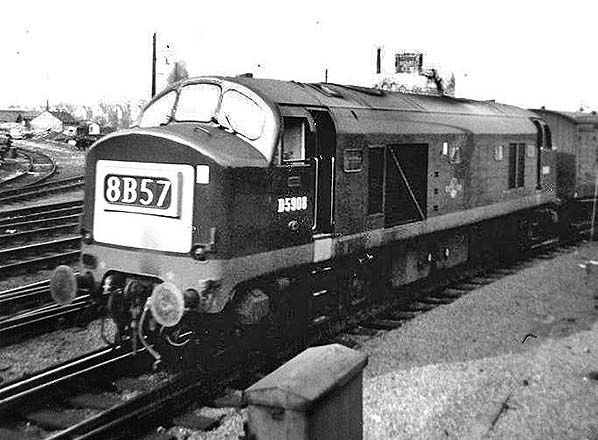
Photo by Stewart Ingram
Above D5908 is seen leaving Cambridge up goods yard, probably around the same time as the previous image. Train 8B57 was the same working the EE Type 1 was seen on in the earlier image. We have already mentioned how Class 55 suffered similar engine problems to the Baby Deltics but nevertheless Class 55 duties on the East Coast Main Line meant their engines ran for long(er) periods at or near full power and this type of work suited the Napier engines better than did the stop-start nature of suburban services. As a result, although Class 55 was far from trouble-free it did manage twenty years of front line service. This is a marked difference to the Baby Deltics which, if we take into count time spent dumped out of service awaiting incessant repairs and rebuilds, barely managed half that. Consideration was given to replacing the Napier engines with the EE unit as used in Class 20 and also to installing the 18-cylinder units as used in Class 55. Perhaps it was just as well this expensive idea was abandoned and Class 23, as the Baby Deltics became, was scrapped. The final pair in service were D5905 and D5909, the latter having received blue livery - the only member of the class to do so. D5909 slightly outlived D5905 and smoked Cambridge out for the final time in March 1971. Latterly they were often seen coupled together working goods trains. The pair languished at Stratford for some considerable time before being scrapped in 1973.
This, however, was not the end of the story. D5901 had been given a new home at The Railway Technical Centre, Derby, where she was used to haul test trains. She was finally scrapped c1977 but her engine survived and at the time of writing is to be installed in a replica Baby Deltic being built using a redundant Class 37 as its basis. Good points of the Baby Deltics? Those who worked on them said they "worked well when they were working well" and that must be as fair a description as any.
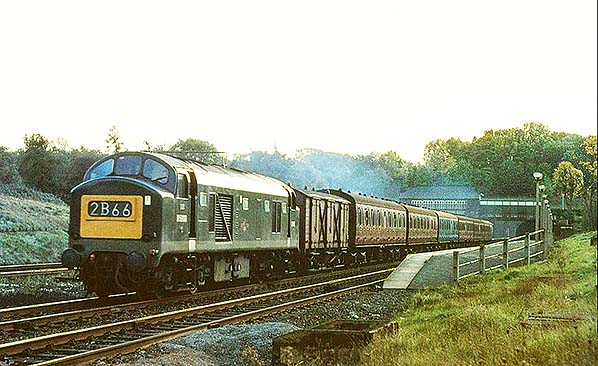
Photo by George Woods from his Flickr Photostream
As has been said, photographs of the non corridor suburban stock at Cambridge during diesel days are hard to find, probably because they arrived in weekday peak hours when people were doing things other than standing on Cambridge station with cameras. We have seen one image of a set of this stock at Cambridge behind a steam locomotive and there are plenty of images showing the stock in carriage sidings opposite the station, but for diesel haulage we are using the above image taken at Hadley Wood in October 1966. Baby Deltic D5906 heads 2B66, a King's Cross - Cambridge stopper. Cambridge trains, stopping or semi fast, do not normally call at stations between Finsbury Park and Potters Bar.
A close look at the train suggests it was hurriedly made up; there are two brake-end vehicles and the other four all appear to have lavatories. The usual formation of a 6-car outer suburban set contained just one lavatory vehicle and one brake-end vehicle. The third carriage is in blue livery. 1966 was the final year in service of the articulated stock, so perhaps some reorganising of stock was ongoing at the time. Note the 'Fruit D' van behind the locomotive; this was unusual but not entirely unknown.
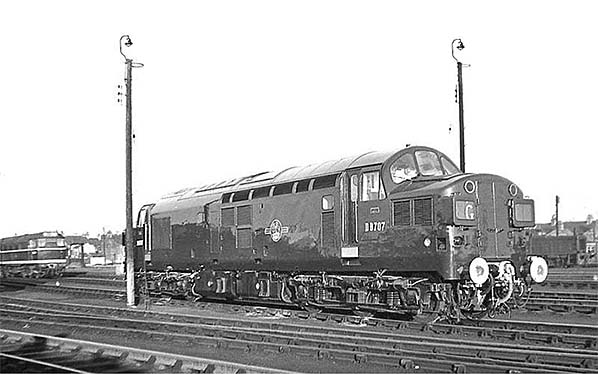
© Chris Burton
The 'pilot scheme' originally designated the planned new diesels as Type A, Type B and Type C. These became Type 1, 2 and 4 respectively. The 'missing' Type 3 came about through a perceived gap in the power range of diesel locomotives and thus was not part of the 'pilot scheme'. Only three Type 3 classes were built; the Southern Region Class 33; the Western Region Hymek Class 35 diesel-hydraulics; the EE Class 37. Classes 33 and 35 were not total strangers to Cambridge; the former being a regular sight most years on specials to Spalding Tulip Festival and the Class 35 Hymek put in the odd rare appearance from the Oxford line. The most prolific type for almost thirty years was the EE Class 37. Introduced from December 1960, the class eventually totalled 309 examples. The class was widely dispersed and those frequent at Cambridge, the D6700 - 29 batch, were based at Stratford, March and initially Ipswich and Norwich. They began to appear on Liverpool Street - Cambridge services from January 1961 and apart from bogie plate fractures were another type which more or less worked straight from the box.
Cambridge never had any main line diesel locomotives allocated. None were necessary, given that Stratford, Hornsey, Finsbury Park and March were not far away. Locomotives were, however, stabled at Cambridge overnight and at weekends. The same applies today with electric multiple units which are based at Hornsey and Ilford. The Brush Type 2, Class 31, had taken over from steam together with the EE Type 4, Class 40, on Liverpool Street - Cambridge and beyond services but the route south of Cambridge is not an easy one. The Brush Type 2 was a capable locomotive within its limits but lacked the power reserve to make up for delays, especially on the stopping services. The EE Type 3 would, it was hoped, eliminate this deficiency. The Brush Type 4, Class 47, it should be remembered, was not introduced until 1962 and apart from the odd appearance from King's Cross was not especially common at Cambridge until the later 1960s.
Above we can see EE Type 3 D6707 on 'the dump' at Cambridge. The date is unknown but the locomotive is obviously brand new. Earlier examples were, as seen, built with the pointless nose-end doors and split headcode boxes. Later examples omitted the doors and had central headcode boxes. During the mid 1960s at least one of the class was fitted with flashing blue lights on its nose ends. The lights were small and flashed in a similar sequential manner to those on the roof of modern police cars. This 'light show' seemed to be operated as the locomotive approached station platforms. Like yellow warning panels, the lights were probably some sort of warning experiment but nothing further is known.
On the left, lurks a Brush Type 2. To its right the water crane which stood at the north end of the goods loop which avoided the station can be seen. On the right of the image a Class 03 shunter is pottering in the goods yard.
D6707 was later to be one of three members of the class to achieve a little bit of dubious fame. It was one of three which received names as follows; D6703 'First East Anglian Regiment'; D6704 ;Second East Anglian Regiment'; D6707 'Third East Anglian Regiment'. The nameplates were fitted early in 1963 but were never unveiled. The three locomotives ran around with the nameplates covered until September 1963 when they were removed, allegedly having never been seen by the public
The reason given for this farce was quite absurd; there were at the time mutterings of a rationalisation of army regiments and naming a locomotive after a regiment which might be disbanded could, it was said, be seen as inappropriate if not offensive. Army regiments and RAF squadrons do get reorganised or disbanded from time to time and always have done, so the excuse seems to be a rather lame one.
It is suspected the real reason was due to an embarrassing error with regard to presentation. The nameplates began with the words First, Second and Third but army regiments usually use the alpha-numeric form such as 1st, 2nd and 3rd An example of this would be the steam and diesel locomotives which bore the name 3rd Carabinier and also the Class 45 diesel named 5th Royal Inniskilling Dragoon Guards 1685 - 1985. The suspected embarrassing error would certainly explain why the locomotive nameplates were never unveiled and then quietly vanished.
Many of the Class 37s, as the EE Type 3 became, have now been scrapped. Others are now on heritage railways but a few are still in service; at the time of writing D6707 is one such, currently numbered 37604.
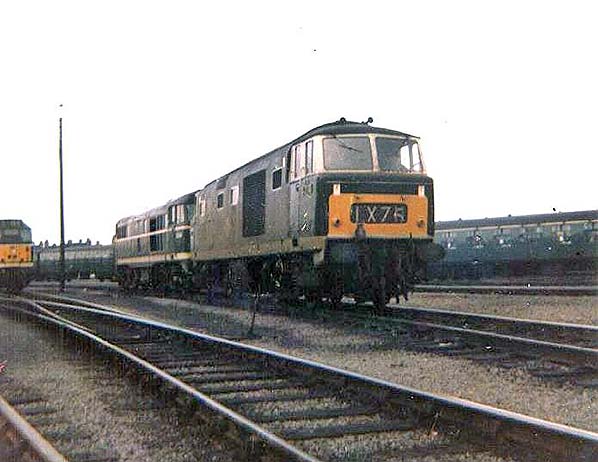
Photo by Stewart Ingram
Talking of the Hymek diesel-hydraulics, above is D7060 on 'the dump'. The date is 10 April 1965 and the Hymek had arrived with a football special from Weymouth. Her train is almost certainly the green Southern stock seen in the background, at least one vehicle of which is a Southern Bulleid coach. The train probably operated via Basingstoke, Reading and Oxford. This was one of two occasions when a Hymek appeared at Cambridge with a passenger train and on a third occasion another of the class arrived with a goods train from the Oxford - Bletchley - Bedford line. The Hymeks (from their Mekydro transmission) were among the better diesel-hydraulic types and were a compact Type 3 design using the Maybach MD870 engine. The last examples bowed out in 1975 and four have survived.
Another diesel-hydraulic type which allegedly came to look at Cambridge on a couple of occasions was the Class 52 Western. The two locomotives concerned are said to have been D1007 Western Talisman and D1008 Western Harrier. Both supposedly arrived from Oxford and at different times but no details of what trains they worked, or why they worked them, are known - if indeed they appeared at Cambridge at all. Class 52 bowed out in 1977 but several have survived, one being certified for main line running. This is D1015 Western Champion, the locomotive which in 1965 returned the empty stock of Sir Winston Churchill's funeral train from Hanborough back to London.
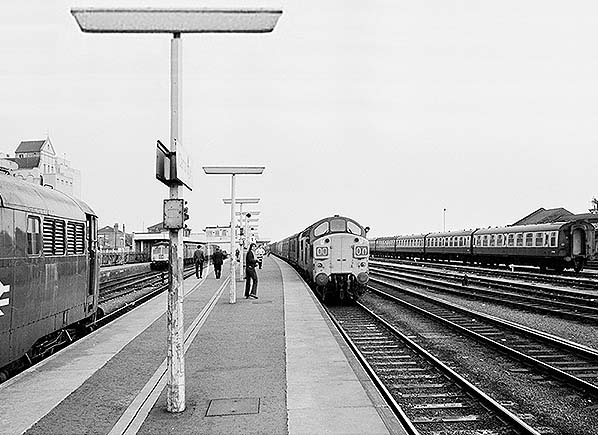
Photo
by David Burrows from his Flickr photostream
Above is a typical scene from the 1970s at the south end of Cambridge station. The year is 1976 and a very bland period at Cambridge; only five routes now served Cambridge, one of which was freight-only, while Classes 31, 37, 47 and DMUs predominated. The only bright spots were when a Class 40, 46 or 55 turned up with a 'Buffet Express' on a fill-in turn from King's Cross, or when something unusual appeared on a freight working, or when ECML trains were diverted. The everyday variety of the early diesel years had gone. At platform 1 a Class 37 waits with a parcels train; it still has its nose-end doors and headcode blinds but by this time headcodes were no longer required to be displayed hence the 00 00. The platform lighting no longer bears the station name and quite why BR thought this change was a good idea is difficult to imagine. A set of Cravens sits in platform 3, no doubt on a King's Cross local service. The Class 31 sitting at the end of platform 2 has likely just been released from its incoming train, probably a 'Buffet Express'. The stock has in all likelihood been dragged out by a Class 03 shunter.
The Prototype Diesel Locomotives
As we have seen, King's Cross often used the short run to Cambridge for fill-in and running-in turns for the larger types of steam and diesel locomotive. This brought some of the experimental diesel prototypes to Cambridge, two of which are seen below.
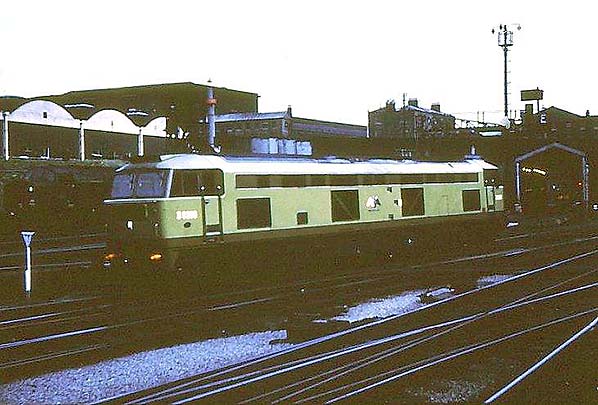
Photo by Phil Sangwell reproduced from Wikimedia Commons under creative commons licence
Above, the Brush D0280 'Falcon' is seen at King's Cross, so named after Brush's Falcon works at Loughborough. As with the BRCW prototype D0260 'Lion', the running number was derived from the locomotives works number but with a 0 prefix to avoid confusion with EE Type 4s D260 and D280. The above image is not of the best quality, probably being taken at either dawn or dusk, but shows the locomotives original paint scheme of lime green and brown, the latter stated as being 'chestnut' brown. The nameplate complete with spread-winged falcon is also visible but partly obscured by what is assumed to be a fault with the original negative.
Brush had for some reason obtained a licence to build German Maybach engines but terms of the licence prevented Brush marrying Maybach engines to hydraulic transmission in any locomotives built for export. It would therefore appear that Brush was looking at the export market when it built 'Falcon' in 1961. The locomotive thus appeared as a diesel-electric using a pair of Maybach MD655 engines, the same engines as used in the Western Class 52. Released from the Brush works on 6 October 1961, Falcon then went to Doncaster for acceptance before making its way, presumably light engine, to Finsbury Park on 13 October. Her very first trip in revenue-earning service was on the 6.52am King's Cross - Cambridge and 10.5am return.
Following this she took up work on the ECML but was sent to Brush for repairs following minor fire damage. Soon after re-emerging she undertook a trial run from Liverpool Street to Norwich, then ended up on freight work between Norwich and Whitemoor. Apparently March used her for a time as a heavy shunter in Whitemoor yard. She then went to the Western Region but at the time the WR had no real experience of electric transmission so 'Falcon' ended up back on the Eastern Region, this time at Darnall (Sheffield). From here she worked the 'Master Cutler' and probably also the 'Sheffield Pullman'; these trains being favourites for prototype locomotives. She then appears to have spent another spell at Whitemoor.
She then spent a good proportion of 1963 back at the Brush works, from which she emerged repainted in a scheme similar to that of the Deltics; Brunswick green with lime green band along the lower bodysides. By 1963 the WR had gained experience with Maybach engines as well as some with electric transmission so 'Falcon' ended up with the WR, based at Bristol Bath Road. Some problems occurred, partly because the WR was suspected of not adhering rigidly to Maybach's maintenance instructions but possibly also because of the uniqueness of the Maybach engine and electric transmission combination.
In December 1970 BR purchased 'Falcon' and she eventually became Class 53 1200 and received blue livery. Having spent time shuffling between passenger work and freight work in South Wales, she was withdrawn on 5 October 1975 and broken up at Cashmores, Newport, in March the following year.
A few problems aside, 'Falcon' was a reasonably successful design as prototypes go and she had covered 550,000 miles in her fairly short life. This mileage was poor compared to the mileages clocked-up by production main line locomotives but was respectable for a prototype. In comparison, even the far from trouble-free Deltics had covered one million miles each by 1967 - just six years into the life of the class.
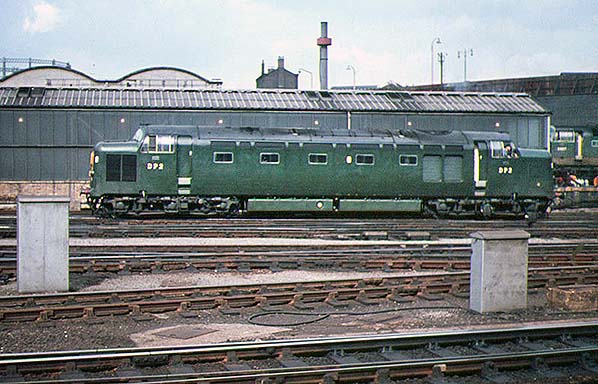
Photo by Phil Sangwell reproduced from Wikimedia Commons under creative commons licence
Above, also at King's Cross and in her original and awfully drab livery is seen the English Electric prototype DP2. This stood for 'Diesel Prototype 2', a follow-on from the prototype Deltic which retrospectively was DP1. The latter had appeared in 1955 and wore a Powder Blue and Primrose Yellow livery which earned it the dubious nickname the 'Ice Cream Van'.
DP2 had a body which broadly resembled that of the Deltics but which differed in detail due to the vastly different internal layout of the locomotive. DP2s body had been built using the Deltic jigs but the story which says DP2 pinched a body intended for a Deltic (D9017) is almost certainly a myth as English Electric would have little to gain by doing this. DP2 was built concurrently with the Deltics but actually appeared just after the last of the latter, D9021, was new. It is possible, indeed likely, that the production team was diverted onto the construction of DP2s body but even so delivery dates for the Deltics were quite consistent. Perhaps Deltic production was stepped back, so what would have been D9018 actually came out as D9017 but it remains doubtful that DP2 carried what was to have been D9017s body. If it did, then the body intended for D9017 would have been at a very early stage of construction but records simply do not support this.
DP2 came into being through a BR requirement for a more powerful locomotive in the Type 4 power range. BR, no doubt through experience, was not too happy with other makes of engine which in any event had been developed about as far as was practicable. The Brush Type 4, Class 47, with its Sulzer 2,750bhp engine, was at the time yet to appear. There seems to have also been a little internal politics active within BR, with a Sulzer v. EE rivalry ongoing.
English Electric had produced an uprated version of its 16CSVT engine which gave 2,700bhp at a sensible 850rpm and the sole purpose of DP2 was to act as testbed for this engine. The 16CSVT engine, incidentally, was a charged-cooled version of the 16SVT engine used in LMS prototypes 10000/1 which at the time developed only 1,600bhp. DP2 was otherwise a conventional locomotive which ultimately proved extremely successful, so much so that the manufacturers engineer who normally travelled with prototypes wherever they went was later rarely present and BR were simply left to get on with it.
DP2 made its first run on 2 May 1962 and following further test runs and crew training entered service on the main line from Euston from 14 May mainly to Crewe, Liverpool and Preston. It then appeared on Carlisle services before having a spell on Blackpool services. In her first year, DP2 covered almost 152,000 miles completely trouble free and, on return to Vulcan Foundry for examination, was found to be in perfect order other than a need for tyre turning - something any locomotive requires from time to time. Back in service, DP2 suffered a couple of problems; during the severe winter of 1962/3 her radiators froze and she also suffered a traction motor flashover. The latter is a trait of DC traction motors and thus was not a specific fault with DP2.
In July 1963 DP2 was sent to Finsbury Park, just at a time when the Deltics were being taken out of service one by one for modifications to their train heating boilers. DP2 thus found herself operating a Deltic diagram and did so perfectly despite having 600bhp less to play with. She could actually out-accelerate a Deltic from rest.
 At some point in 1965 during an overhaul, DP2 lost her dreadful green livery and was given the same two-tone livery as the Deltics had received. Some locomotives looked acceptable in single-tone unrelieved green whereas others did not - the Deltics and DP2 did not. From October 1966 DP2 was placed on a diagram which covered the 01:15 King's Cross - York and 08:00 return. This meant she spent much of the day idle at King's Cross so in the same time honoured fashion of fill-in turns she was put to work on Cambridge services and is known to have operated the 13:05 ex King's Cross and return and a second service during the evening peak. The duties continued into November when DP2 was taken out of service for some electronic wizardry to be fitted, this work being undertaken at Finsbury Park. Following this, DP2 again appeared on Cambridge services, this time the 09:05 ex King's Cross and return. Following this and to accumulate mileage, she was put back onto main line duties which included a spell at Leeds and a spell on King's Cross - Edinburgh services and it was on these duties that DP2 met her end on 31 July 1967. The Cliffe - Uddingston cement train had derailed near Thirsk and DP2, unable to stop in time, collided with the derailed wagons and received severe damage. There is some evidence that EE made a half-hearted attempt to repair DP2 but it was not to be and she was ultimately scrapped. Given that the road to the BR diesel fleet was a somewhat bumpy one, the fate of DP2 was a tragedy as she was a perfectly good and capable locomotive.
At some point in 1965 during an overhaul, DP2 lost her dreadful green livery and was given the same two-tone livery as the Deltics had received. Some locomotives looked acceptable in single-tone unrelieved green whereas others did not - the Deltics and DP2 did not. From October 1966 DP2 was placed on a diagram which covered the 01:15 King's Cross - York and 08:00 return. This meant she spent much of the day idle at King's Cross so in the same time honoured fashion of fill-in turns she was put to work on Cambridge services and is known to have operated the 13:05 ex King's Cross and return and a second service during the evening peak. The duties continued into November when DP2 was taken out of service for some electronic wizardry to be fitted, this work being undertaken at Finsbury Park. Following this, DP2 again appeared on Cambridge services, this time the 09:05 ex King's Cross and return. Following this and to accumulate mileage, she was put back onto main line duties which included a spell at Leeds and a spell on King's Cross - Edinburgh services and it was on these duties that DP2 met her end on 31 July 1967. The Cliffe - Uddingston cement train had derailed near Thirsk and DP2, unable to stop in time, collided with the derailed wagons and received severe damage. There is some evidence that EE made a half-hearted attempt to repair DP2 but it was not to be and she was ultimately scrapped. Given that the road to the BR diesel fleet was a somewhat bumpy one, the fate of DP2 was a tragedy as she was a perfectly good and capable locomotive.
In effect, DP2 was the prototype for the Class 50 fleet but this fleet achieved nowhere near the reliability of DP2 for a number of reasons. DP2 was a regular sight at Cambridge for a time yet, to date, not a single photograph of her at or near Cambridge has come to light.
Great Northern Line Headcodes
Several mentions have been made of headcodes when describing diesel locomotives above and those for the King's Cross outer suburban services are worth an additional mention. While the Liverpool Street line eventually standardised on a simple xLxx system with the third and forth characters indicating specific trains, the King's Cross suburban network used a local headcode system which did not identify specific trains but their destination. Those applicable to Cambridge passenger services were:
- King's Cross and Cambridge or intermediate via Hertford - 2B57
- Moorgate and Cambridge or intermediate via Hertford - 2B58
- Broad Street or Finsbury Park and Cambridge or intermediate via Hertford - 2B59
- King's Cross or Hitchin and Cambridge - 2B66 (with 1B66 being the 'Buffet Express')
- Moorgate and Cambridge via Welwyn Garden City - 2B76
- Broad Street and Cambridge via Welwyn Garden City - 2B96
Others were used for empty stock and goods working, based on the above but differing according to the type of train as seen in the image of D5908. The above system has long since been abandoned with Great Northern line electric trains being either 1Cxx or 2Cxx and King's Lynn trains being either 1Txx or 2Txx with third and fourth characters identifying specific trains. Liverpool Street line electric trains are now generally 2Hxx with third and fourth characters identifying specific trains.
Click here to continue Part 7:
British Railways the Diesel Era








 The Napier Deltic engine was, as we have seen, 2-stroke and this obviously necessitated inlet and exhaust ports in the cylinder liners. These liners cracked around the ports, allowing coolant into the cylinders. This in turn caused piston seizure which resulted in connecting rods being ejected, often at high velocity, through the side of the crankcase. If only this was the only problem with the Baby Deltics. They suffered cooling problems and ancilliary equipment was a constant source of trouble. It would appear EE themselves may have been partly to blame; the British Transport Commission placed the order but EE were late issuing the internal order which allowed construction to begin. This in turn, it seems, was the reason why EE bought-in a number of components which, to use a modern term, were 'unfit for purpose'. There may also be a connection between this and BR initially refusing to accept the locomotives as they came out overweight (a common problem at the time), modifications having to be made to reduce weight.
The Napier Deltic engine was, as we have seen, 2-stroke and this obviously necessitated inlet and exhaust ports in the cylinder liners. These liners cracked around the ports, allowing coolant into the cylinders. This in turn caused piston seizure which resulted in connecting rods being ejected, often at high velocity, through the side of the crankcase. If only this was the only problem with the Baby Deltics. They suffered cooling problems and ancilliary equipment was a constant source of trouble. It would appear EE themselves may have been partly to blame; the British Transport Commission placed the order but EE were late issuing the internal order which allowed construction to begin. This in turn, it seems, was the reason why EE bought-in a number of components which, to use a modern term, were 'unfit for purpose'. There may also be a connection between this and BR initially refusing to accept the locomotives as they came out overweight (a common problem at the time), modifications having to be made to reduce weight.






 At some point in 1965 during an overhaul, DP2 lost her dreadful green livery and was given the same two-tone livery as the Deltics had received. Some locomotives looked acceptable in single-tone unrelieved green whereas others did not - the Deltics and DP2 did not. From October 1966 DP2 was placed on a diagram which covered the 01:15 King's Cross - York and 08:00 return. This meant she spent much of the day idle at King's Cross so in the same time honoured fashion of fill-in turns she was put to work on Cambridge services and is known to have operated the 13:05 ex King's Cross and return and a second service during the evening peak. The duties continued into November when DP2 was taken out of service for some electronic wizardry to be fitted, this work being undertaken at Finsbury Park. Following this, DP2 again appeared on Cambridge services, this time the 09:05 ex King's Cross and return. Following this and to accumulate mileage, she was put back onto main line duties which included a spell at Leeds and a spell on King's Cross - Edinburgh services and it was on these duties that DP2 met her end on 31 July 1967. The Cliffe - Uddingston cement train had derailed near Thirsk and DP2, unable to stop in time, collided with the derailed wagons and received severe damage. There is some evidence that EE made a half-hearted attempt to repair DP2 but it was not to be and she was ultimately scrapped. Given that the road to the BR diesel fleet was a somewhat bumpy one, the fate of DP2 was a tragedy as she was a perfectly good and capable locomotive.
At some point in 1965 during an overhaul, DP2 lost her dreadful green livery and was given the same two-tone livery as the Deltics had received. Some locomotives looked acceptable in single-tone unrelieved green whereas others did not - the Deltics and DP2 did not. From October 1966 DP2 was placed on a diagram which covered the 01:15 King's Cross - York and 08:00 return. This meant she spent much of the day idle at King's Cross so in the same time honoured fashion of fill-in turns she was put to work on Cambridge services and is known to have operated the 13:05 ex King's Cross and return and a second service during the evening peak. The duties continued into November when DP2 was taken out of service for some electronic wizardry to be fitted, this work being undertaken at Finsbury Park. Following this, DP2 again appeared on Cambridge services, this time the 09:05 ex King's Cross and return. Following this and to accumulate mileage, she was put back onto main line duties which included a spell at Leeds and a spell on King's Cross - Edinburgh services and it was on these duties that DP2 met her end on 31 July 1967. The Cliffe - Uddingston cement train had derailed near Thirsk and DP2, unable to stop in time, collided with the derailed wagons and received severe damage. There is some evidence that EE made a half-hearted attempt to repair DP2 but it was not to be and she was ultimately scrapped. Given that the road to the BR diesel fleet was a somewhat bumpy one, the fate of DP2 was a tragedy as she was a perfectly good and capable locomotive.
 Home Page
Home Page